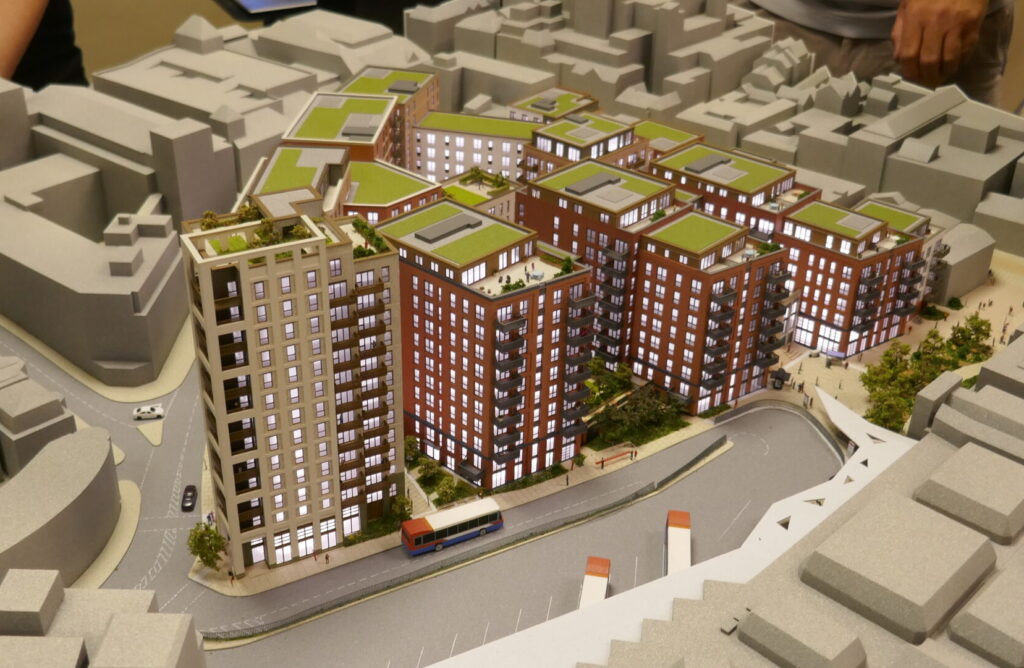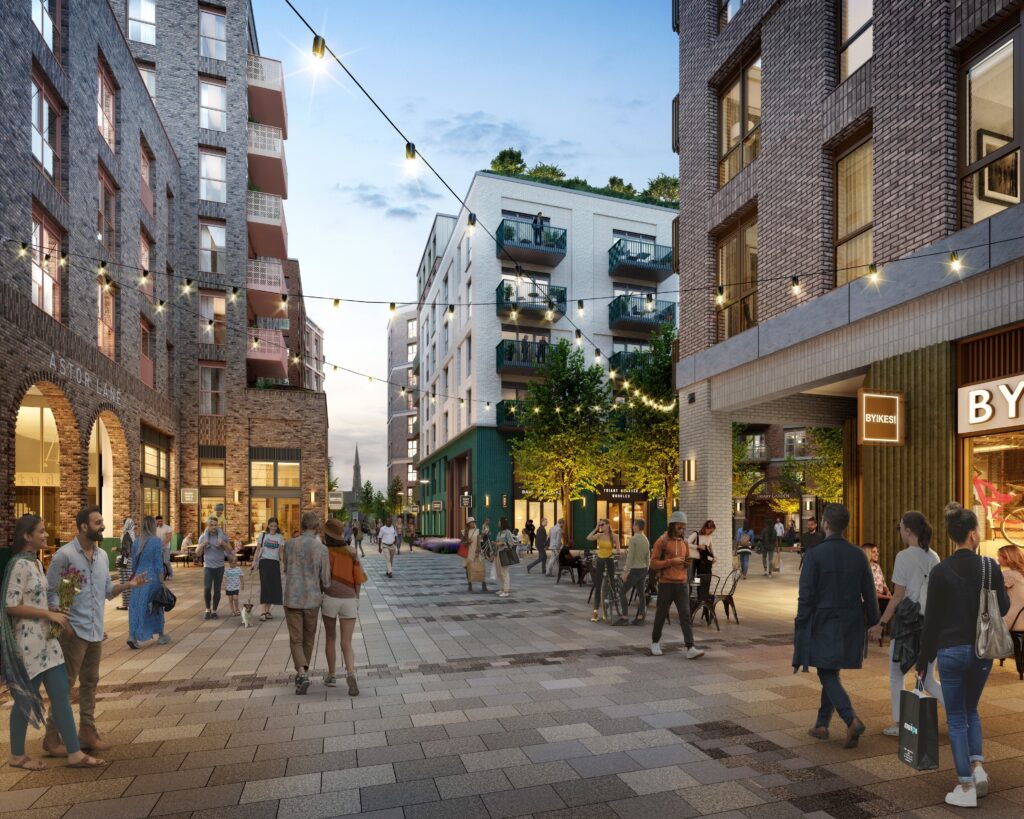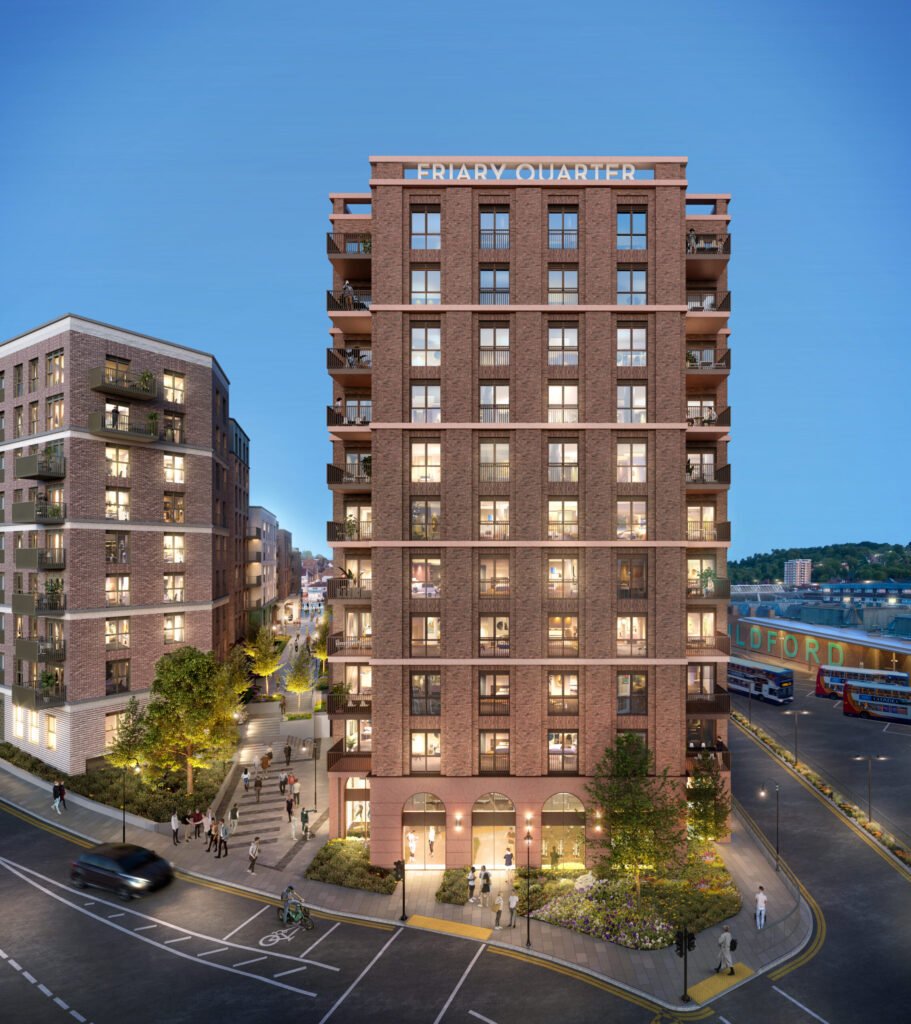 Abraham Lincoln
If given the truth, the people can be depended upon to meet any national crisis...
Abraham Lincoln
If given the truth, the people can be depended upon to meet any national crisis...
 Guildford news...
for Guildford people, brought to you by Guildford reporters - Guildford's own news service
Guildford news...
for Guildford people, brought to you by Guildford reporters - Guildford's own news service
Comment: Guildford Will Get Higher – Sadly, There’s No Turning Back
Published on: 13 Oct, 2023
Updated on: 16 Oct, 2023
By Martin Giles
This is an updated version of an article published on August 14
See: Guildford North Street Plans With 471 New Homes Approved 13 Votes to 2
Anyone who was misguided into believing that voting Lib Dem or Conservative in May would stop the North Street development now know they were mistaken.
 Both parties were happy to sit back and allow voters to be persuaded that votes for their parties could really make a significant difference to the North Street proposal. Some Conservative candidates have privately admitted they were delighted with the effect of the Battle for Guildford video with its nasty innuendos. Some even promoted it. It was shameful.
Both parties were happy to sit back and allow voters to be persuaded that votes for their parties could really make a significant difference to the North Street proposal. Some Conservative candidates have privately admitted they were delighted with the effect of the Battle for Guildford video with its nasty innuendos. Some even promoted it. It was shameful.
The slick webinar by St Edward, the consortium formed by M&G and Berkeley Homes, issued in July, made it very clear: they were submitting a new, slightly modified, application and if that was refused they would rely on an appeal of the original application but, of course, it wasn’t blackmail.
See: North Street: Approve ‘Smaller, Higher Quality Scheme’ and We Will Withdraw Appeal Says Developer
The appeal would have almost certainly succeeded; the council had withdrawn all but two of their grounds for refusal – so the message to those on the Planning Committee on Wednesday night was crystal clear: approve the new application or accept the risk of the first the application, with its higher buildings and even fewer affordable units being granted permission.
And, of course, using taxpayers’ money to fight an expensive appeal, while warning that the council is still at risk in the medium-term of effective bankruptcy, making cuts to popular public services necessary, would be extremely difficult to justify. Alternatively, approval would mean GBC gets paid the undisclosed amount (but bound to be £millions) from selling its portion of the site to St Edward.

The developer’s model of the original North Street development proposal refused by GBC’s Planning Committee. The application was subject to appeal. No model was produced for the second application.
On top of that, if the Planning Committee refused the new application and the appeal was unsuccessful, St Edward had said it was likely to walk away leaving the GBC Planning Committee members to be seen as responsible for keeping the North Street site an unattractive blot on the landscape as it has been for years.
Who would be a councillor?
By the way, claims put about that the council could have then stepped in to buy the site and build their own scheme were always arrant nonsense.
The Local Plan made high-rise buildings inevitable
The fact is that higher-rise buildings in Guildford were inevitable from the time the council failed to include a height limit policy in the Local Plan in 2019.
See: Second Leaked Tory Email Shows Some Were Very Concerned About Building Height
As we know from leaked emails, there was a belated realisation among the ruling Conservative councillors, in the wake of the unpopular appeal decision to allow Solum’s “Great Wall” of ten-storey blocks at the station site, that Guildford had an inadequate defence against high-rise proposals and that the planning officers’ advice that such a policy was unnecessary or undesirable was wrong.
Most Conservative councillors were themselves worried about more high-rise development. But there was no time to redraft the Local Plan and get it adopted before the 2019 election.
They rushed in a supplementary planning document (SPD), which it was hoped would limit building heights by protecting specified views, but the North Street development has clearly shown how weak and ineffectual it is.
Why they felt it so necessary to have their Local Plan adopted before the 2019 election remains a moot point. They say it was to protect the borough from uncontrolled development but residents in some parts of the borough, Ash and the eastern wards, might find this risible.
Others say it was connected with the desire of some councillors to be seen to comply with government or party policy. Whichever was the truth, it appears that delay might have been preferable. It would certainly have been more democratic.

Aerial view of the North Street regeneration site. No one argued that the site should not be re-developed.
There was a second chance under the Lib Dem/R4GV coalition when Part 2 of the Local Plan was considered. Two lone voices, Ramsey Nagaty, then leader of GGG, and R4GV member Chris Barrass, argued for such a policy to be included but council officer advice was that it was not needed and no one else either noticed or cared. It was a terrible decision and for many will remain an indictment against GBC as a whole.
Wednesday night’s decision
Fast forward to Wednesday, how would the different parties have viewed the new application?
The Lib Dems were largely responsible for the refusal of the first application but was there sincere concern about building height among a majority of its councillors? Their bigger concern seemed to be the percentage of affordable housing.
The target figure for “affordables” in the Local Plan is 40 per cent but developers simply argue that is not viable and the percentage in the new scheme was much lower, just 10 per cent, with a condition that it cannot be reviewed even if profit margins increase.
The Lib Dems might say that shaving of a couple of floors from the 13-storey building was a significant change (even though it seems quite possible they could be added in later years under “permitted development”) but few of those opposed to the scheme are likely to be persuaded. For those to whom the scale, mass and bulk of the scheme is anathema, it still is.
The Conservatives faced a trickier choice. The North Street scheme is being considered under planning policies and a Local Plan that their party had implemented. But at the January Planning Committee, and in the last borough election, they aligned themselves with those who were against the scheme.
The Tories might be gambling on the fact the electors’ memories are often short and the understanding of who is responsible for what, especially when it comes to planning policy, is not widespread.
Residents for Guildford & Villages are also in a cleft stick. More than any other party they promoted the scheme. They thought it would be an election winner. Instead it proved divisive and under the first past the post system it cost them votes and seats they could ill afford.
Some in their party remain convinced the development is the right thing and, anyway, to have U-turned would have looked hypocritical. But former supporters who hate the plans might find it impossible to forgive them, let alone vote for them again.
The Guildford Greenbelt Group’s sole representative on the Planning Committee in January, its former leader Ramsey Nagaty, voted for the plan in January. GGG’s main objective is to preserve the green belt and so his replacement, Pat Oven, as predicted, followed suit and voted in favour of the new application.
The hope of people in the villages forming GGG’s heartland is that the more houses that are developed in Guildford, the lower the demand for green belt development. Not that that is likely to reduce those scheduled on the strategic sites at Wisley, Gosden Hill and Blackwell Farm, nor further green belt grabs when, as seems likely, the pressure from national government for yet more homes continues as the country’s population inexorably grows.
It was a similar situation in the Labour Party where, again entirely predictably, the new Labour member Howard Smith voted for the new application, but more because he was simply in favour of the development rather than any hope to protect the green belt. That’s not his thing.
In the end, only one Lib Dem and one Tory voted against the scheme. Many are likely to find the volte-face of the Lib Dem position and two of the Tories as difficult to accept. No doubt we will be told they all voted as individuals and, to be fair, the majority were not on the Planning Committee in January.
But one thing all the parties seemed united on in the local election campaigns was that a zoned height policy was needed.
In May, a response from an anonymous “Lib Dem spokesperson” told The Dragon: “We are in favour of a heights policy, and will look to implement one as soon as practicable, potentially as part of a SPD in advance of the Local Plan Review.” But now, with the Lib Dems in charge, there appears to have been little progress, of course election campaigning has stopped for another four years.
And for those who feel that more high buildings will damage further the character of the town the future looks bleak. The fact is the battle on building height was lost some years ago without most of us even realising it.
And for those who welcome the scheme it will now go ahead, hardly changed. Not only that. Given the inevitable ratchet effect, more higher-rise buildings can be expected. There will be no going back.
See also:
North Street Approval is Good News for Guildford
The Guildford Society Agrees with GRA – The North Street Scheme Is Seriously Flawed
Responses to Comment: Guildford Will Get Higher – Sadly, There’s No Turning Back
Leave a Comment Cancel replyPlease see our comments policy. All comments are moderated and may take time to appear.

"Found any?" - "Nope, it all looks green to me!" (See Opinion: The Future is Congested, the Future is Grey)
www.abbotshospital.org/news/">





Recent Articles
- Latest Evidence in Sara Sharif Trial
- Ash’s New Road Bridge Is Named – and November 23rd Is Opening Day
- Class A in Underwear Leads to Jail Sentence
- Historical Almshouse Charity Celebrates Guildford in Bloom Victory
- Notice: Shalford Renewable Showcase – November 16
- Firework Fiesta: Guildford Lions Club Announces Extra Attractions
- Come and Meet the Flower Fairies at Watts Gallery
- Updated: Royal Mail Public Counter in Woodbridge Meadows to Close, Says Staff Member
- Letter: New Developments Should Benefit Local People
- Open Letter to Jeremy Hunt, MP: Ash’s Healthcare Concerns


Recent Comments
- Paul Spooner on Ash’s New Road Bridge Is Named – and November 23rd Is Opening Day
- Harry Eve on Opinion: The Future is Congested, the Future is Grey
- Nigel Keane on Letter: New Developments Should Benefit Local People
- Nathan Cassidy on Updated: Royal Mail Public Counter in Woodbridge Meadows to Close, Says Staff Member
- T Saunders on Opinion: The Future is Congested, the Future is Grey
- Jim Allen on Updated: Royal Mail Public Counter in Woodbridge Meadows to Close, Says Staff Member
Search in Site
Media Gallery
Dragon Interview: Local Artist Leaves Her Mark At One of England’s Most Historic Buildings
January 21, 2023 / No Comment / Read MoreDragon Interview: Lib Dem Planning Chair: ‘Current Policy Doesn’t Work for Local People’
January 19, 2023 / No Comment / Read MoreA3 Tunnel in Guildford ‘Necessary’ for New Homes, Says Guildford’s MP
January 10, 2023 / No Comment / Read More‘Madness’ for London Road Scheme to Go Ahead Against ‘Huge Opposition’, Says SCC Leader
January 6, 2023 / No Comment / Read MoreCouncillor’s Son Starts Campaign for More Consultation on North Street Plan
December 30, 2022 / No Comment / Read MoreCounty Council Climbs Down Over London Road Works – Further ‘Engagement’ Period Announced
December 14, 2022 / No Comment / Read MoreDragon Interview: GBC Reaction to the Government’s Expected Decision to Relax Housing Targets
December 7, 2022 / No Comment / Read MoreHow Can Our Town Centre Businesses Recover? Watch the Shop Front Debate
May 18, 2020 / No Comment / Read More









Jose Fiuza
October 16, 2023 at 3:18 pm
Maybe if all but two councillors, from the whole spectrum of political parties at GBC, ended up in favour of this development (or in many cases the even higher and worse previous plan) they’re right? Perhaps we should consider that as a possibility?
This plan is clearly better than the first (and taking highest building from 13 to 11 floors is an important change). So it’s not illogical to have been against the first version and in favour of this one, like most Conservatives and Lib Dems.
Ultimately if there is a huge increase in population, which there is, and they all want to live in London and the South East, which broadly they do, extra housing has to be built. So the only issue is where? Unless you think house prices should rise even more.
So the GGG position is logical – avoid building on green belt by building higher in centre. Although, that way lies Woking…
Or one could actually try to cut immigration, but that’s really not working either.
Or pretend there is some fake, easy solution, well R4GV tried that a few years back and of course it turned out not to be true.